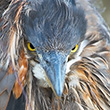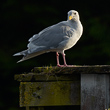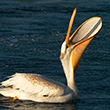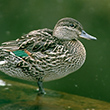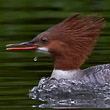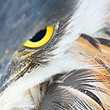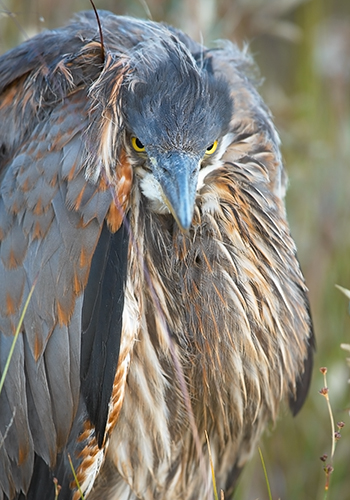
Availability: Limited Edition Print; RM Stock (??)
In the Field
One Unhappy Bird. Columbia Lake, BC, Canada. July 24, 2005.
I've always found it interesting how members of different species can communicate clear messages, even without a shared language. This young Great Blue Heron had no problem whatsoever in letting me know that it was NOT happy that I was disturbing its sleep!
I encountered this bird early one morning in a wetland area near our home. Even though it appeared to be sleeping, I didn't think I had much of a chance getting close enough to it to get a good shot. So...I REALLY took my time in moving from about 50 metres distant from the bird to my final shooting position (about 4 metres from the bird). My "stalk" probably took the better part of an hour - one painstakingly slow step at a time!
Once in position I faced one major photographic challenge - deciding on what parts of the heron I wanted in sharp focus and what parts I wanted thrown out of focus. Initially I thought I needed both the eyes and the distal tip of the bill in focus. Given the paucity of available light and my forced aperture choice (wide open), I quickly discovered this was impossible. So...I sacrificed keeping the bill in focus and went for the eyes and breast plumage AND the large dark feather below the bird's right eye. I think I made the right choice - virtually anyone seeing this image is drawn first to the eyes and then to the dark feather - no one has ever mentioned to me that the tip of the bill is fuzzy!
Behind the Camera
One Unhappy Bird. Columbia Lake, BC, Canada. July 24, 2005.
Digital Capture; Compressed RAW (NEF) format; ISO 200.
Nikon D2X with Nikon 200-400 mm f/4G ED-IF AF-S VR lens @ 400 mm (600 mm equivalent with digital conversion factor) supported on Gitzo 1348 carbon fibre tripod with Wimberley head. VR turned to "On" and in "Normal" mode.
1/50s @ f4; no compensation from matrix-metered exposure setting.
At the Computer
One Unhappy Bird. Columbia Lake, BC, Canada. July 24, 2005.
RAW Conversion, including first-pass sharpening, exposure compensation, and tone curve adjustment, using Phase One's C1 Pro.
All further digital correction on 16-bit TIFF file using Adobe's Photoshop CS2, including selective saturation enhancement and selective sharpening for web output.
Conservation
One Unhappy Bird. Columbia Lake, BC, Canada. July 24, 2005.
Ten percent of the revenue generated by this image will be donated to Wildsight.
Species Status in Canada*: Pacific subspecies (Ardea herodias fannini) listed as species of Special Concern (April 1997); other populations and subspecies not currently considered at risk.
The Great Blue Heron (Ardea herodias) is the largest, most wide-spread and best known of the North American Herons. Great Blue Herons are monogamous but breed colonially in congregations known as rookeries. Legal protection of rookeries in many parts of North America have had positive results on their populations. Currently most of North America's populations of these birds are considered healthy and stable.
This immature Great Blue Heron was photographed in the Columbia Valley of the East Kootenays. Many ecosystems within the Columbia Valley face development pressure, including pressure from logging operations. Wildsight is an effective conservation organization that protects biodiversity and promotes sustainable communities in Canada's Columbia and Rocky Mountains. Support for Wildsight, through donation or becoming a member, will help ensure that they remain effective in their efforts to conserve threatened or endangered species and ecosystems.
*as determined by COSEWIC: The Committee on the Status of Endangered Wildlife in Canada



















